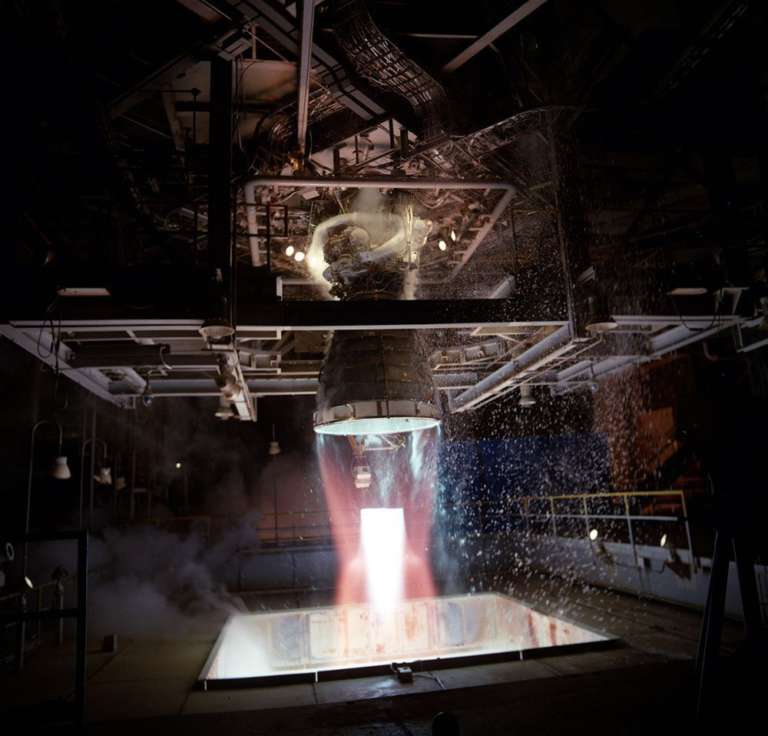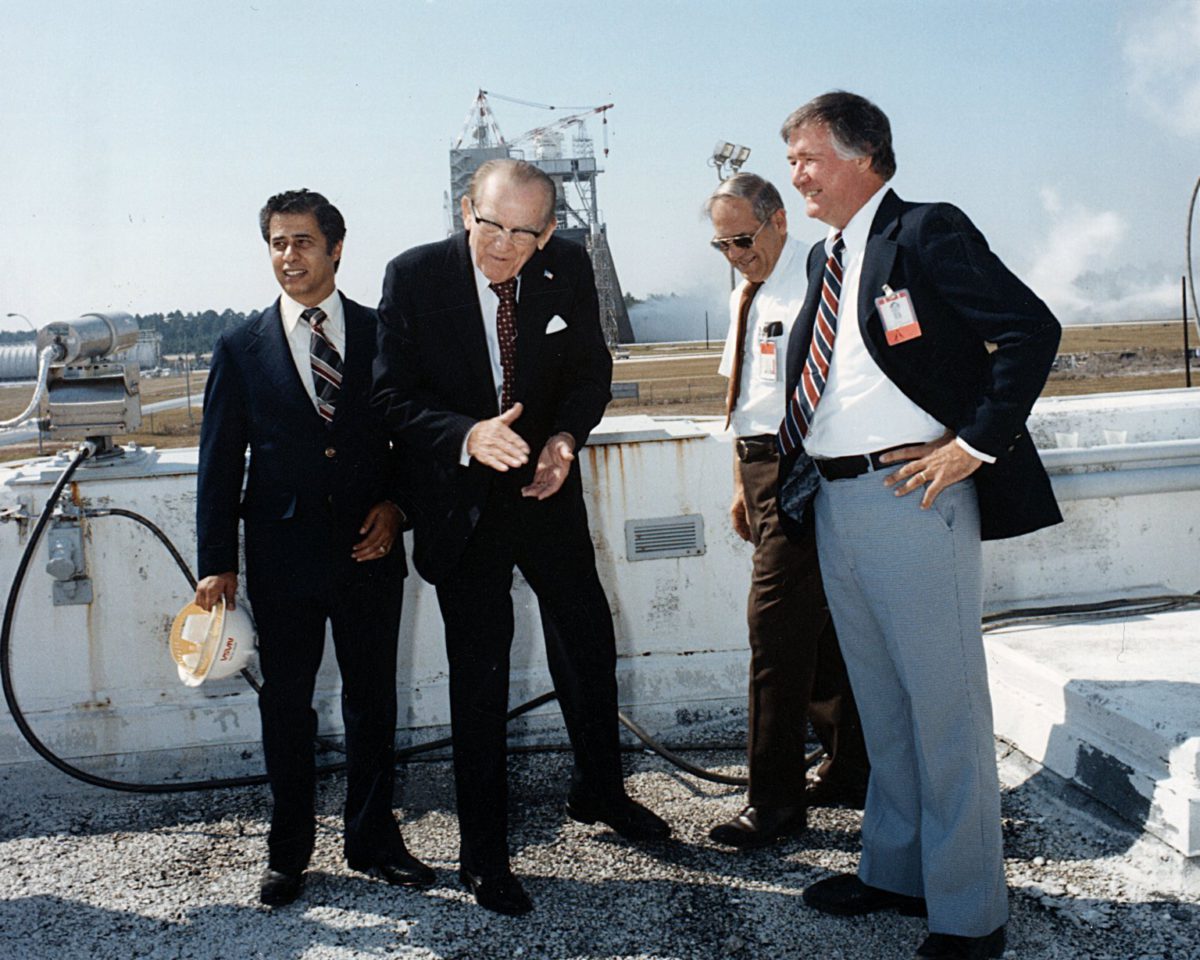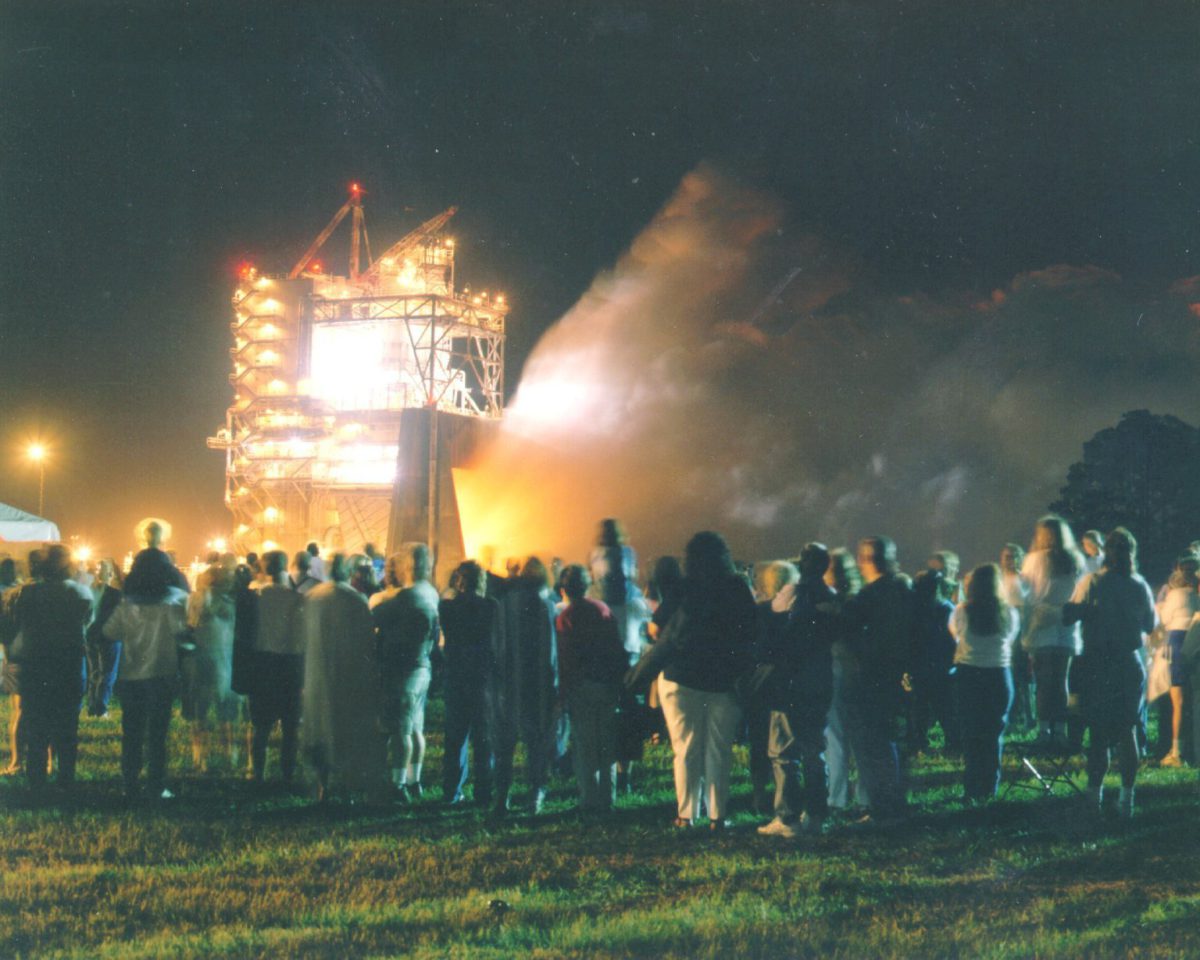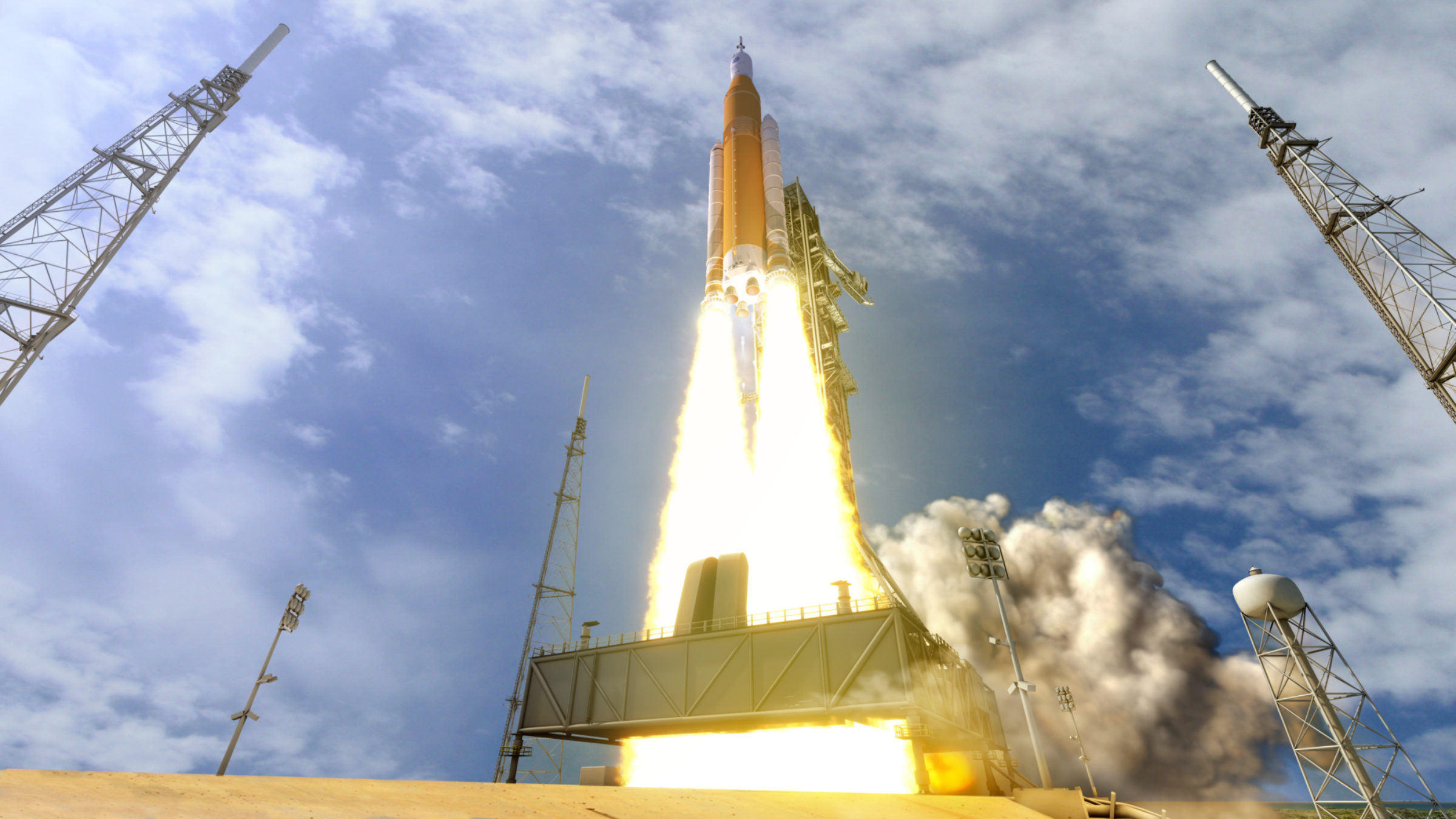Jason Davis • May 09, 2016
All the way to orbit: After 35 years, is the RS-25 still the Ferrari of rocket engines?
Two months ago, a rocket engine that will one day blast a crew of astronauts to the moon was test-fired at NASA's Stennis Space Center in Mississippi.
The engine was RS-25 number 2059, formerly a space shuttle main engine, last used in 2001 during the final flight of Endeavour. Shortly thereafter, Endeavour became a cherished museum exhibit at the California Science Center in Los Angeles. But its engines—along with those from Discovery and Atlantis—were swapped with replicas and quietly stowed away.
Those leftover powerplants—16, in all—became hand-me-downs for the Space Launch System, NASA's new heavy lift rocket. The SLS core stage is powered by four RS-25s, and engine 2059 is slated for use on the rocket's second flight, a crewed trip to the moon expected between 2021 and 2023.
But unlike the shuttle, SLS will not reuse its engines—they'll be destroyed with the core stage when it tumbles back into the atmosphere. That means the engine's manufacturer, Aerojet Rocketdyne, will eventually have to build new ones. NASA already awarded the company $1.6 billion to start getting its production line ready.
These two disparate use cases for the RS-25 often trigger great consternation among armchair rocket scientists. Here is a selection of comments posted to some recent SLS engine test articles:
"The real Ferrari rocket engine of the 21st century is Space X's Raptor engine. NASA should invest in the future with this engine rather than the past with an outdated RS-25..." —Spaceflight Now commenter
"...A great step towards turning the reusable Space Shuttle main engine into a non-reusable version!" —The Planetary Society commenter
"NASA is going to be building these RS-25 "Space Shuttle main engines", and then THROWING THEM AWAY after just one launch! That is reprehensible." —TechCrunch commenter
"...a 1960s style Saturn V copy without any reusability." —Universe Today commenter
Tough crowd.
Untangling critiques like these are difficult—it's hard to evaluate the RS-25 without looking into SLS, and when you do that, you eventually start treading into politics. The rabbit hole goes pretty deep.
But let's dive in anyway. Or, at least, wade in far enough to decide whether the RS-25 is still a good rocket engine, and whether it's the right engine for SLS. I did some research and talked to rocket scientists from NASA, Aerojet and an independent company. The answers I got were both simple and complex.
Rocket to anywhere
In a perfect world, selecting a rocket engine would be all about performance. You could create a giant spreadsheet comparing thrust-to-weight ratios, specific impulses (efficiency metrics), and payload capabilities.
I actually tried that. But some of those numbers are hard to pin down with complete certainty. Case in point: SpaceX just posted new payload capabilities for their Falcon 9 rocket.
In reality, you have to include logistical considerations like the availability of the engine and the track record of its manufacturer. Cost is obviously important, and not just the per-engine price tag—there are development costs, operational costs, and the money required to run the ground systems that fuel and launch different vehicles.
More importantly, there are safety considerations: Is the engine reliable? Can we trust it to carry expensive payloads? Or, in some cases, people?
In the end, you can perhaps best evaluate an engine by asking a simple question: Is it the right engine for your rocket, and what you want that rocket to do?
Glenn Case is a propulsion engineer who works for Generation Orbit, an Atlanta-based company that builds and hopes to soon fly air-launched rockets. Air launchers carry a rocket to a certain spot and drop it. The rocket then flies to suborbital, or even orbital destinations.
Before GO, Case worked on rocket engines at both NASA and Blue Origin, so he's seen a broad sample of both old-school and cutting-edge engine technologies.
"The selection of an engine is really mission-based," Case told me. "What's your mission? You need to define that before anything."
If you're an SLS critic, this is the where you say, "SLS has no missions." Officially speaking, the rocket's manifest contains just two Orion spacecraft flights to lunar orbit.
But while some people mock SLS as a rocket to nowhere, another way of looking at it is that it's a rocket to anywhere. It can carry staggeringly large payloads into orbit—up to 130 tons, eventually—making it the most powerful launch vehicle since the Saturn V. And just like the Saturn V, it will carry people.
That means the two most important factors for an SLS engine are performance and reliability.

Performance and reliability
The RS-25 is certainly reliable. It powered space shuttles 135 times during three decades of service. The engine flew successfully all but once. In 1985, a sensor malfunction caused an RS-25 on Challenger to shut down early. Challenger still made it to space and completed its mission. Counting that one failure, the RS-25 has a reliability rating of 99.7 percent.
What about performance? NASA has called the RS-25 "the Ferrari of rocket engines." Is that true?
Steve Wofford manages the liquid engines program for SLS at NASA's Marshall Space Flight Center in Huntsville, Alabama. "The RS-25 is the best rocket engine in the world—by a mile," he said, during a recent phone interview. "In terms of efficiency, performance and demonstrated reliability, RS-25 is an absolute marvel of engineering that no liquid propulsion system in its thrust class can match. Nobody's even close."
The RS-25 was one of the world's first staged combustion engines, which placed it years ahead of its time. In the simplest of terms, a staged combustion engine utilizes all of its turbine exhaust by capturing it and feeding it back into the engine. It's a closed-cycle design. The alternative is an open-cycle, gas generator or tap-off design that ends up dumping some of that exhaust overboard.
"The closed cycle is typically higher performing," said Glenn Case. "You're not throwing the turbine drive gas overboard."
But that extra performance comes with higher engine pressures and more complexity, a problem that occasionally spelled disaster during early space shuttle engine tests at Stennis Space Center. The RS-25 wasn't so much developed as it was tamed.
One of the only other closed-cycle, first stage liquid engines flying today is the RD-180, the controversial Russian-built powerplant used to power the Atlas V. Open-cycle, first stage engines include those used on Soyuz, the Delta IV, and SpaceX's Falcon 9.
"If you're designing a vehicle that's low cost, expendable and commercially viable, you might be able to use a slightly lesser performing engine," Case said. This helps explain why SpaceX, which is focused on reusability, high launch rates and streamlined, low-cost hardware, would initially choose an open cycle for Merlin, the engine that powers the Falcon 9.
The Falcon 9 uses nine Merlin engines to produce 1.5 million pounds of thrust at liftoff. Just four RS-25s, on the other hand, produce 1.7 million pounds of thrust, and that's not counting the two solid rocket boosters that will be strapped to the Space Launch System's sides.
All liquid engines produce more thrust as the rocket ascends toward the vacuum of space. But when the Falcon 9's first stage falls away a couple minutes into flight, only a single Merlin is left to power the second stage, producing 210,000 pounds of thrust. For SLS, the four core stage RS-25s power onward, producing more than 2 million pounds of thrust above Earth's atmosphere.
That makes the RS-25 worthy of NASA's "Ferrari" moniker. But Ferraris are expensive, and for a low-cost, medium-lift launcher, the Falcon 9 is equally impressive. "SpaceX has done a great job in marrying a high-performing engine with a gas generator cycle," said Case. "They're squeezing a lot of performance out of that, which is great."
RS-25 - The Ferrari of Rocket Engines Video: NASA / MSFC
Old technology?
The RS-25 was developed in the 1970s, but NASA and Aerojet are quick to point out that today's RS-25 is hardly the same engine developed four decades ago. "When people say it's an old engine, it really is not," said Jim Paulsen, vice president of program execution for advanced space and launch programs at Aerojet Rocketdyne. "These [improvements] are not just changing the color of the engine, or changing a line—there have been fairly significant upgrades that were run as we were flying."
Since its development, the engine has been through five major overhauls. One of the most obvious enhancements has been to thrust levels. By the end of the shuttle program, the engine was running at 104.5 percent of its original power output. For SLS, that number jumps to 109 percent. That strains the engine and compromises reusability (which no longer matters), but it's still within safety tolerances. Aerojet's next version of the RS-25 will aim for 111 percent.
Paulsen said upgrades made during the shuttle program include new turbomachinery, a new main combustion chamber, and a new powerhead. The engine controller—the brain of the RS-25—has evolved, and is doing so again for SLS. One of the engine's most cutting-edge features is a monitoring system that watches vibrations and temperatures across all phases of flight, and uses those data to evaluate whether the engine is performing normally.
This allows an engine to shut down at the first sign of trouble, and conversely, false alarms are weeded out—something a more generalized monitoring system can't do.
"I think it's one of the only rocket engines that flies with advanced health management," Paulsen said. "You don't want to shut down a perfectly good engine. That's a bad day."
Reusability
As NASA works to get SLS up and running for its 2018 shakedown cruise, the agency's rocketry efforts are often overshadowed by SpaceX and Blue Origin. Both companies have pulled off first stage booster landings, making stunning advances toward the holy grail of cheap, reusable rocketry.
SLS will not be reusable. The RS-25 was, of course, a reusable engine—the first-ever, in fact. After reaching orbit, the shuttle ditched its external fuel tank, while the main engines remained attached to the orbiter and returned to Earth. All but two of the 16 remaining RS-25 engines have already flown in space. That makes the prospect of unceremoniously ditching them tough to swallow.
But on SLS, there's no practical way to recover the engines. The core stage pushes the vehicle all the way to orbit. That means it can't fly back to Cape Canaveral or land on a barge in the ocean—at least, not without atmospheric reentry capabilities. I asked NASA where the stage would reenter, and was told it would vary depending on each mission profile. For Exploration Mission 1 in 2018, the tank will travel halfway around the world before breaking up over the Pacific Ocean.
"It's sort-of a sustainer-type engine," said Steve Wofford of the RS-25. "You have high-thrust boosters which burn for about two minutes and then drop off, and long-running hydrogen engines that get you from the ground all the way to orbit."
Even if NASA were to re-engineer the vehicle to make recovery an option, it's questionable whether the business case would make sense. SLS could cost between a half-billion to a billion dollars per flight, or even more—estimates are still fuzzy. Combined with a low flight rate, the cost savings gained from reusability probably wouldn't be high enough to bother.
During the shuttle program, reusability savings turned out to be highly ambitious due to the vehicle's lower-than-advertised flight rate. One former high-ranking NASA official told me there's an old joke around the agency that you can measure your tenure by the lowest space shuttle flight cost you remember.
SLS will fly even less than the shuttle. After the rocket's first two test flights, NASA hopes to ramp the launch rate up to once per year. By comparison, in 2015, Soyuz launched about a dozen-and-a-half times, the Atlas V flew nine times, and the Falcon 9 was close behind at seven—including a launch failure that grounded the vehicle for several months. The case for reusability is stronger when there are high flight rates, which help an organization overcome the logistical costs associated with launching a rocket, such as production facilities and ground systems.

The promise of methane
Both SpaceX and Blue Origin are developing new engines that use liquid methane for propellant. The RS-25, on the other hand, uses liquid hydrogen, while many other first-stage engines use RP-1, a blend of refined kerosene. All of these fuels must be combined with liquid oxygen to burn, similar to the way an automobile engine needs both gasoline and air.
What's the difference?
Hydrogen is the first element on the periodic table, meaning it's the lightest. It releases the most energy when burned, and it burns clean, which, in the space shuttle's case, made it good for reusability.
The Atlas V RD-180 uses RP-1. So does SpaceX's Falcon 9 Merlin. RP-1 is less efficient and heavier, but on the other hand, it's denser, so your fuel tank can be smaller. And at sea level, it actually produces more thrust. It's also cheaper and easier to deal with, since it doesn't need to be supercooled like liquid hydrogen.
So which is better? "It all depends on what you need out of a stage," said Steve Wofford. "Liquid hydrogen was the best propellant for the SLS stage and what we needed it to do, in combination with the solids. For a single stage to orbit, hydrogen is the best option."
If, on the other hand, your rocket uses multiple stages during its climb to orbit, RP-1 might be a better bet for the core stage. The Atlas V and Falcon 9 are in good company with this approach—the mighty Saturn V used RP-1 at liftoff.
The efficiency of a rocket engine—essentially, how much change in velocity it delivers per quantity of propellant consumed—is measured in seconds of specific impulse, a metric known as Isp. The RD-180, which runs on RP-1, has a sea-level Isp of 311 seconds. The RS-25, burning hydrogen, is more efficient, at 366 seconds.
An in-between option is liquid methane. Glenn Case told me that in theory, methane offers about ten more seconds of Isp over RP-1. "Engine designers will kill for a few extra seconds of Isp," he said.
Methane doesn't need to be as cold as hydrogen, which makes it easier to work with. It also burns cleaner than RP-1, making it attractive for reusable engines. SpaceX is using methane for their new Raptor engine, while Blue Origin chose it for their upcoming BE-4. Both of those engines will also employ closed-cycle designs, giving them increased performance.
Cost
Depending on whom you ask, NASA paid about $60 million each for its current fleet of RS-25 engines. Coincidentally, that's about the same price SpaceX advertises for an entire Falcon 9 flight.
SLS and the Falcon 9 are two very different launch vehicles bound by separate programmatic and technical constraints. But there's no way around the glaring truth that SLS is incredibly expensive.
Aerojet says they plan to reduce the cost of the RS-25 by 33 percent. The savings will come from modernizing production lines to increase efficiency, as well as advances in materials science. Steve Wofford said engineers can now forge and cast large engine parts more precisely, rather than casting rough shapes and spending thousands of hours machining them to their final forms. "We're taking advantage of 40 years' worth of manufacturing lessons learned in building this engine," he said.
Another cost-saving technique is the utilization of additive manufacturing, or 3-D printing.
"My office is really leading the charge across NASA—and in many respects, across industry—in additive manufacturing technology as applied to rocket engines," Steve Wofford said.
So is a 33 percent cost reduction realistic? "I certainly think it would be doable," Glenn Case said, while noting that every manufacturing change is a potential trade-off in terms of demonstrated flight reliability, since new components must be shown to be as sound as the ones they replace. "In the rocket business, we are a slow folk to change," he said.

Politics
There's one more engine selection factor that arguably carries as much weight as all others combined: politics.
The NASA Authorization Act of 2010 legally requires SLS to be built using space shuttle-derived technology, and to utilize the shuttle program's workforce where practical. The story behind the Act is complex, but it passed the Senate unanimously, cleared the House by a margin of 304 to 118, and was signed into law by President Obama.
This combination of requirements narrowed the engine selection field significantly. When SLS was created in 2011, the only other realistic choice for a reliable, American-built, high-performance, first-stage engine was Aerojet's RS-68, which powers the Delta IV.
At one point, the RS-68 was considered for the Ares V, a heavy lift SLS predecessor that was part of the now-defunct Constellation program. But the engine has never carried astronauts. NASA and Aerojet would have had to find ways to make it safer and more reliable, adding costs.
NASA also could have started from scratch, but that would have been even more costly and time-consuming. Plus, there was the whole shuttle workforce aspect of the Authorization Act to contend with, and the law said SLS should be operational by the end of 2016—a deadline NASA is already going to miss. That really left only one option: the RS-25.
The heavyweight champion
Not surprisingly, both Wofford and Paulsen believe NASA made the right call in selecting the RS-25 for SLS. "They had 16 of them, and they had flown on the shuttle," Paulsen said. "They had gone through major development on it, so they understood the engine very well. So you've got to balance that investment with developing a whole new engine."
Glenn Case agreed. While he preferred not to side with any particular rocket configuration, he said it was hard to argue against the RS-25. "It's such a high-performing engine that has relatively high thrust and high reliability," Case said. "I can't disagree with the decision to use that, especially since they do have stockpiled engines and the flight rate is relatively low."
In the five years since SLS was announced, NASA is on the brink of entrusting astronauts' lives to two new rocket systems: the Falcon 9, which will carry SpaceX's new Crew Dragon, and the Atlas V, which will launch the Boeing CST-100 Starliner. For now, those spacecraft will remain tethered to low-Earth orbit, ferrying crews back and forth to the International Space Station.
But SpaceX recently announced the Crew Dragon won't be bound there for long. The company is on the cusp of debuting the Falcon Heavy, essentially three Falcon 9 rockets bolted together, capable of launching a whopping 54 metric tons to low-Earth orbit. That will eclipse the capability of all current launch vehicles except SLS.
As soon as 2018—the same year SLS debuts—SpaceX says they plan to start sending Dragons to Mars using the Falcon Heavy. Details have yet to be publicized, and the space firm's timelines often slip. But given SpaceX's continuing run of impressive successes, it's hard not to take the pledge seriously.
The aforementioned 2010 NASA Authorization Act created SLS and all but cemented the RS-25 as the vehicle's engine of choice. The law was a compromise between a presidential administration that wanted to radically change NASA's direction and a Congress that was unwilling to strongly deviate from business as usual. Space policy doesn't play a large role in presidential elections. But soon, a new administration will have the opportunity to tweak NASA's direction.
Rocket science, when greenlit to proceed, is largely immune to politics. Two more RS-25s will be in the test stand this year at Stennis, and next year, the Space Launch System's entire core stage will rumble to life for a test in the Mississippi bayou. For now, the RS-25 remains the current heavyweight champion of the rocket engine world, and it looks to keep that title for the foreseeable future.
The Time is Now.
As a Planetary Defender, you’re part of our mission to decrease the risk of Earth being hit by an asteroid or comet.
Donate Today

 Explore Worlds
Explore Worlds Find Life
Find Life Defend Earth
Defend Earth


